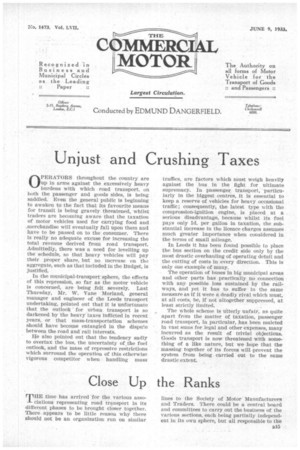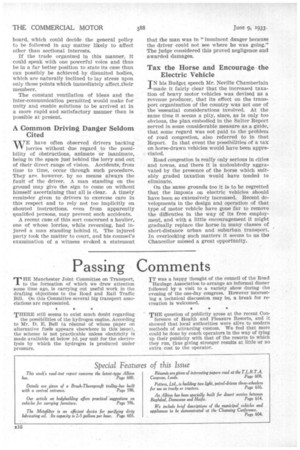Close Up the Ranks
Page 29

Page 30

If you've noticed an error in this article please click here to report it so we can fix it.
11HE time has arrived for the various asso ciations representing road transport in its different phases to be brought closer together. There appears •to be little reason why there should not be an organization run on similar lines to the Society of Motor Manufacturers and Traders. There could be a central board and committees to carry out the business of the various sections, each being partially independent in its own sphere, but all responsible to the board, which could decide the general policy to be followed in any matter likely to affect other than sectional interests.
If the trade organized in this manner, it could speak with one powerful voice and thus be in a far better position to state its case than can possibly be achieved by disunited bodies, which are naturally inclined to lay stress upon only those points which immediately affect ,their members.
The constant ventilation of Ideas and the Inter-communication permitted would make for unity and enable solutions to be arrived at in a more rapid and satisfactory manner than is possible at present.
A Common Driving Danger Seldom Cited
AVE have often observed drivers backing lorries without due regard to the possibility of obstructions, animate or inanimate, being in the space just behind the lorry and out of their direct range of vision. Accidents, from time to time, occur through such procedure. They are however, by no means always the fault of the driver. A man standing on the ground may give the sign to come on without himself ascertaining that all is clear. A timely reminder given to drivers to exercise care in this respect and to rely not too implicitly on shouted instructions, even from apparently qualified persons, may prevent such accidents.
A recent ease of this sort concerned a haulier, one of whose lorries, while reversing, had injured a man standing behind it. The injured party took the matter to court, and his counsel's examination of a witness evoked a statement that the man was in "imminent danger because the driver could not see where he was going." The judge considered this proved negligence and awarded damages.
Tax the Horse and Encouragethe Electric Vehicle
TN his Budget speech Mr. Neville Chamberlain 1-made it fairly clear that the increased taxation of heavy motor vehicles was devised as a revenue producer, that its effect on the transport organization of the country was not one of the -essential considerations involved. At the same time it seems a pity, since, as is only too obvious, the plan embodied in the Salter Report served in some considerable measure as a guide, that some regard was not paid to the problem of road congestion, also referred to in that Report. In that event the possibilities of a tax on horse-drawn vehicles would have been appreciated.
Road congestion is really only serious in cities and towns, and there it is undoubtedly aggravated by the presence of the horse which suitably graded taxation would have tended to eliminate.
On the same grounds too it is to be regretted that the imposts on electric vehicles should have been so extensively increased. Recent developments in the design and operation of that type of motor vehicle have gone far to remove the difficuties in the way of its free employment, and with a little encouragement it might gradually replace the horse in many classes of short-distance urban and suburban transport. In overlooking such matters it seems to us the Chancellor missed a great opportunity.




























































































